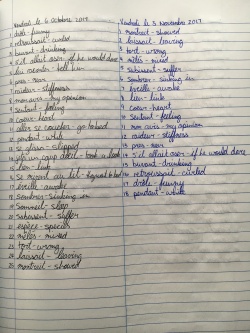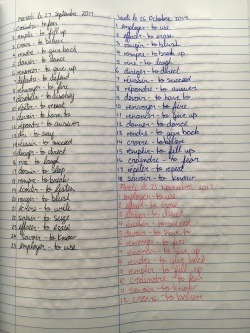The Goldlist method, developed by David J. James, allows you to commit a large amount of vocabulary to your long-term memory through a relaxed and stress free process. This concept is based on the theory that small blocks of study time (approximately 20 minutes) separated by short breaks (about 10 minutes) used in conjunction with spaced repetition will allow you to bypass your short term memory and learn large quantities of vocabulary with relatively little effort.
One of the best things about this process is that it doesn’t really feel like work. In fact, to be effective this process requires the learner to take their time and enjoy the process of physically writing words down and reading allowed while avoiding trying to actively memorise. Much the same as you wouldn’t “cram” for an exam, the Goldlist method spaces out blocks of study time and uses “distillations” to commit words to your long-term memory in a more natural way.
What you will need:
- A notebook with at least 34 lines and each page divided in half. You can do this yourself with a ruler if you can’t find one with an existing division
- 4 different coloured pens or markers; something you feel comfortable writing with
- A source of words and phrases
- A small amount of time you can set aside each day to study
The Process:
Step 1
- Write the numbers 1 – 25 on the far left column of your Notebook
- Taking your time, write the word or phrase in your target language followed by the translation in your source language
- Once you have completed your list of 25 words read them over once out loud
This first list is called your head list and the process should take about 20 minutes to complete. Once your head list is completed you will leave it for a minimum of 2 weeks but no more than 2 months. This is to ensure that the effects of short term memory have completely dissipated.

Step 2
- Opposite to your head list write the numbers 1 – 17 using a new colour.
- Read aloud the words from your head list seeing which ones you have the most difficulty recalling.
- Re-write the words that you had trouble recalling.
- Once you have finished your list of 17 of the words you had the most difficulty recalling read the list out loud.
This becomes your first distillation. The words that you were able to remember are already committed to your long-term memory. Once again, take your time writing and enjoy the process. After you have finished, take a break for at least 10 minutes and do something completely unrelated. You will come back to this list again in a minimum of 2 weeks but no more than 2 months.

Step 3
- Below your first distillation and using a new colour, write the numbers 1 – 12
- Read aloud the words from your first distillation and once again, identify which you have the most difficulty recalling.
- Re-write the 12 words that you had the most trouble remembering
- Read your list out loud
This list is your second distillation and you should already have learned more than half of your original list of words. Be sure to take your time reading and writing and set aside a small break afterwards. Again, you will revisit this list in at least 2 weeks but no more than 2 months.

Step 4
- Using a fourth colour, write the numbers 1 – 8 below your original head list.
- Read aloud the words from your second distillation.
- Re-write the 8 words that you still had the most trouble remembering
- Read the list aloud
This is your final list – this should be the 8 most troublesome words for you to recall. This list should have taken you approximately one month to arrive at and is fairly safe to say that you have learned about 70% of your initial 25 words. From here you can take these 8 words and incorporate them into other study methods discussed below or carry them over into further Goldlist books.

Check out this video made by Language enthusiast Christopher Huff for a great visual guide.
Why this works:
The key to this method is to take your time and passively acquire vocabulary through spaced repetition and the process of physically writing it out. By limiting your study blocks to about 20 minutes each followed by 10 minute breaks you are ensuring that you brain is focused and activated to learn new words. Waiting a minimum of 2 weeks allows for any effect of short term memory to have worn off. This means that the words that you easily recognise are already ingrained in your long-term memory. If you cycle between new head lists and various distillations each day you will quickly amass a book filled with 3,750 words.
Overall, the Goldlist method provides a great alternative to flashcards and memory mnemonics. Many people find the act of writing to be relaxing and an escape from computers and mobile devices. So find a quiet place where you can work undisturbed, take your time and enjoy the process of writing. Not only will your penmanship improve but you will quickly see your vocabulary increase exponentially.
i’ve heard about this method but never really understood how it works ’til i found your post, so thank you!! i just have one more question, do you create a new list everyday?
LikeLike
Hey Sophia,
Thanks so much! It has really made a huge difference in my vocabulary. With that being said, consistency is key. It is really easy in the first two weeks to write out 3-4 head lists a day (The lists of 25 words written in black in my examples). But as time passes the daily commitment grows exponentially as you have to keep up with all of your distillations.
My advice to you is to write 1 or 2 head lists a day for the first two weeks and then continue to write one head list a day after that while completing your distillations. This will ensure that you don’t fall behind. My routine is to write a new head list everyday and then complete one of each distillation. This keeps the workload manageable. It takes about 30 min total – sometimes I do it in one sitting and sometimes I space it out.
Hope that helps but feel free to as any other questions you might have! Thanks for reading!
LikeLike
Pingback: Intensive Vs. Extensive: How to read effectively in your target language – Language for Life
Pingback: 5 tips for a successful language exchange – Language for Life